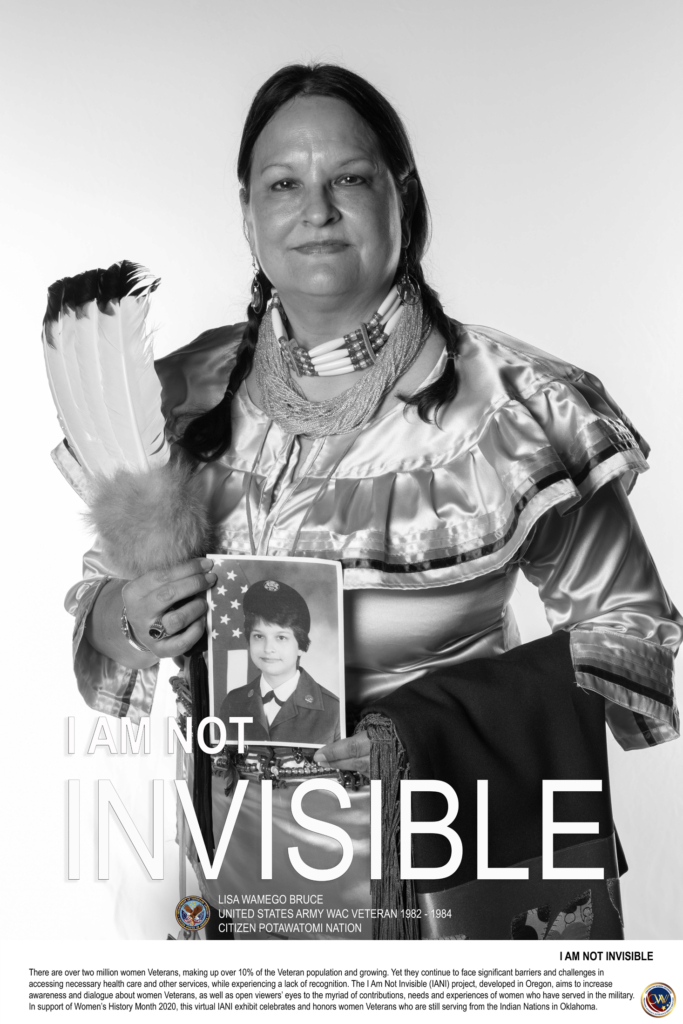Each year, the United States celebrates former military service members and their sacrifice for the country on Nov. 11 — Veterans Day. And each year, the demographics of the different branches become more diverse. Women comprise 10 percent of U.S. armed services, and one in 69 adult women is a veteran. Combined with the fact that Native Americans serve at the highest rate per capita of any population, Native women comprise a significant group of veterans.
The U.S. Department of Veterans Affairs Center for Women Veterans began the I Am Not Invisible campaign in 2019. Encompassing eye-catching black-and-white portraits of women veterans, the series also includes a set of photos highlighting Native women.
I Am Not Invisible featured Citizen Potawatomi Nation tribal member and Army Veteran Lisa Wamego Bruce in 2019. The Wamego, Bruno and Vieux family descendant joined the Army in November of 1982 and left the service in June of 1984 while stationed in Korea to have her first child in the United States.
“You can do a lot more than you think you can, and you can put up with a lot more than you think you can,” Bruce said of her time in the military. “So, it taught me to trust myself and not give up.”

Training and deployment
Bruce began basic training at 21 years old after feeling a need for guidance and direction. She wanted to hone her skills while traveling and gaining experience, and the Army seemed like the solution. A member of an all-female basic training class, Bruce acted as a squad leader. She also qualified as a sharpshooter with her rifle and disassembled and reassembled her M-16 the fastest in her platoon.
“I got to ride in a helicopter back to barracks instead of having to march back to barracks because I shot the best in the whole company,” Bruce said. “That was my highlight of my Army career.”
She ended up training in microwave communication systems. Bruce had never studied electronics before and quickly found she enjoyed the material and showed great proficiency.
“My recruiter was just overwhelmingly impressed with my scores and the opportunity that opened up for me, which is one of the reasons I wanted to go in the military to get some training that would help me when I got out. And that was very highly skilled,” she said.
Bruce eventually earned a distinguished graduate designation. She was the only woman in her class who completed the microwave communication system repairs courses. Afterward, the Army deployed her to Korea, and she became part of a team that traveled to sites often on the tops of mountains to maintain those systems.
“On the weekends is mostly when I would do my work because we would go out to our different sites (to) run PMs and tests and do calibration for the site,” Bruce said.
She lived off-base in central South Korea with her now ex-husband and left the Army in June 1984 in anticipation of the birth of her first child.
“It’s not for everybody, but (military service) can do so much good for you,” Bruce said. “I recommend it if you don’t already have an educational plan. But go in when you’re young.”
Family and tradition
In 2019, Bruce visited the Chilocco Indian School near Newkirk, Oklahoma, for her I Am Not Invisible portrait. Her father attended the boarding school as a child. Teachers and staff forced the students to abandon their Native language, dress and culture at the risk of severe punishment.
“There’s still a lot of buildings there, and a lot of them are dilapidated and falling in, and then some of the newer ones are still standing,” Bruce said. “And they had it open for that day so people could tour it. … But it was just sad to think of the things that we know that went on there.”
Years later, her father joined the military and continued the family’s service tradition. She and her three brothers all served in either the Army, Marines or Navy.
“My brothers tried to talk me out of joining when I decided to go in because there weren’t a lot of females in the Army at the time, and they were worried for me. But I made up my mind. And so, I did it,” Bruce said.
Her two sons also joined the Army and spent their first tours in Korea nearly a decade apart.
“I think (being stationed in Korea) helped me be able to understand what my sons would experience because I had been there before, so I could handle it better.” Bruce said.
Her time in the Army also inspired her nephew during his service.
“He said that he thought, ‘Well, if Aunt Lisa can do this, I can do it too.’ So, that’s how he got through basic the whole time,” Bruce said.
While she wishes she had shared her time in the Army with more women, Bruce remains grateful for the experience. She now gives back to veterans as a member of Kimberly-Clark’s SALUTE nonprofit and the Oklahoma Women Veterans Organization Tulsa chapter.
“We work with a lot of different veteran groups that help educate and try to help get them to the place that they need to be to get the help that they need. … Some aren’t in a position where they want help or will ask for help. So it’s really just trying to open their eyes to the fact that there is help out there,” Bruce said.
The U.S. Department of Veterans Affairs projects the number of women veterans to increase by approximately 200,000 over the next 20 years, showing they will continue to remain an essential part of the U.S. armed services.
Look at the I Am Not Invisible campaign at va.gov/womenvet/iani and on Facebook @VAWomenVets.
